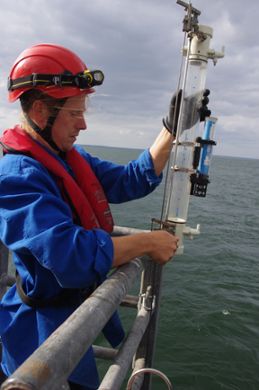“The first joint research trip has already departed on the Aranda. Finnish and Swedish marine researchers will initially intercalibrate their instruments and take samples to measure oxygen levels and the phosphorus and nitrogen content. In parallel, we are drawing up a joint-programme for future marine environmental monitoring,” says Lea Kauppi, Director-General of SYKE.
“The rewards of the collaboration are immense. Both Sweden and Finland's research will gain access to more environmental data and faster access to each other's data. At the same time we can share the costs of vessels, equipment and personnel,” says Lena Häll Eriksson. “This is also a very good solution to solve our need of access to a research vessel.”
SMHI and SYKE will now conduct research trips each month in the Baltic Sea and the North Sea. Some sea areas are common areas of investigation: Gulf of Bothnia, the Åland Sea and the northern part of the Baltic Proper. The new collaboration means Aranda will now also cover the southern part of the Baltic Sea and the the western Swedish sea areas (The Sound, Kattegatt and Skagerrak).
Marine environmental monitoring is based on the HELCOM (Baltic Marine Environment Protection Commission) assessment programme and EU directives.

Follow changes in the sea

The measurements and analyses from the research trips provide important information about changes to the environment in the Baltic Sea, the Kattegatt and Skagerak, and this forms decision-making support for governments, agencies and businesses, etc. The three most pressing environmental issues - which are also interrelated - are:
1. Oxygen conditions, which have deteriorated since the 70s and have reached alarming levels in the Baltic Sea. Today some 30% of the bottoms suffer from very low oxygen levels, and 15% are completely dead (the area including out the Gulf of Bothnia, Kattegat and Skarerrak)(News article January 2014.) The cause of this is eutrophication, combined with increasingly lower inflow of cold, salt, and therefore more oxygen-rich water from the North Sea. We do not currently know the causes of the poor water inflow, but suspect that it may be due to climate change.
2. Eutrophication is caused by nutritive salts containing nitrogen and phosphorus from discharges around the Baltic Sea. However, the negative trend has been broken thanks to, among others, the improvement of municipal and industrial waste waters treatment in several countries. The reversal process still takes a long time, as discharges are stored in the bottom sediment and enter via watercourses from fields and woodlands, and via rain from traffic emissions on land and sea.
3. Algal situation is monitored and forecasted through biological and chemical measurements as a complement to satellite data and automatic measurements from merchant ships. Certain algae can be harmful.
The collected environmental data of the institutes will now be possible to share quickly between countries, and a great deal of the data is also open and accessible via the SMHI website at www.smhi.se and via SYKE's data system. Annual data from each country will also be made available through the International Council for the Exploration of the Sea ICES and via HELCOM.